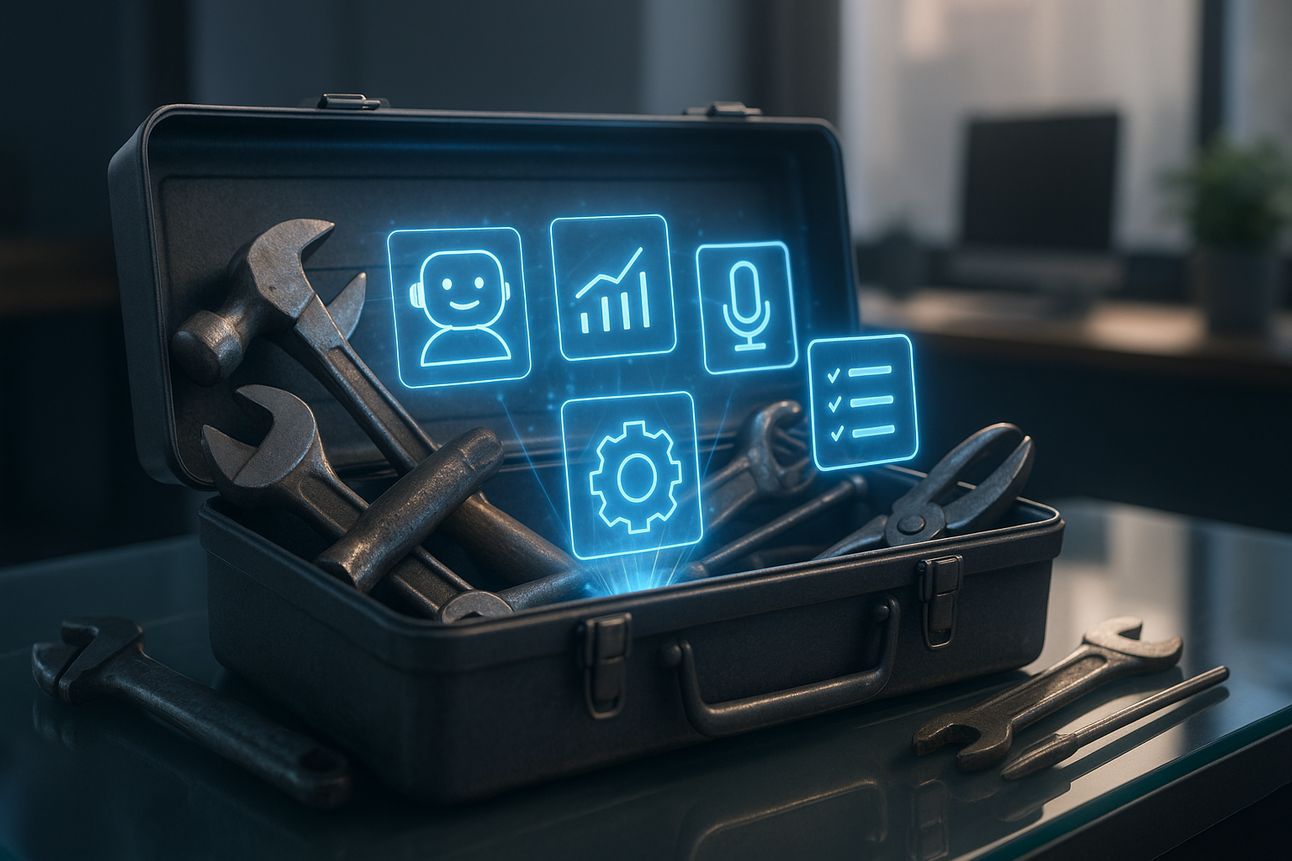One Sunday morning, not too long ago, I sat down to figure out how to connect ChatGPT with Notion. It was meant to be a quick experiment.
Instead, I uncovered a dozen ways to reduce busywork, streamline content production, and rethink how I prep each edition of this newsletter.
What used to take an hour now takes five minutes. But the real insight wasn’t just efficiency—it was realizing I hadn’t checked what was newly possible.
In enterprise settings, this kind of inertia is everywhere. We wait to act until someone else proves the value. But with AI, the speed of change flips that dynamic: the earlier you act, the bigger the payoff.
You don’t need to be first with every innovation—but you do need a rhythm of exploration. Otherwise, your competitors will find the edge before you do—and use it to do things your team still sees as impossible.

🔮 AI Lesson - Troubleshoot Anything with ChatGPT
🎯 The AI Marketing Advantage - Google vs. OpenAI: The Fight for Search
💡 AI CIO - LLM-Based Code Validation for DevOps
🎙️ AI Confidential Podcast - On the Cutting Edge of Agentic AI with João Moura
📚 AIOS - This is an evolving project. I started with a 14-day free Al email course to get smart on Al. But the next evolution will be a ChatGPT Super-user Course and a course on How to Build Al Agents.


Don’t Drift—Ride the AI Wave
How to Spot Emerging Capabilities Before They Become Industry Standards
One of my favorite writers is Hunter S. Thompson—maybe because he was a rebel but also because he was incredibly effective at getting to the quick of things by writing in an entertaining and off the wall way.
One of my favorite quotes from the infamous gonzo journalist, is a letter to his friend Hume Logan.
“To be, or not to be: that is the question: Whether ’tis nobler in the mind to suffer the slings and arrows of outrageous fortune, or to take arms against a sea of troubles … ” (Shakespeare)
And indeed, that IS the question: whether to float with the tide, or to swim for a goal. It is a choice we must all make consciously or unconsciously at one time in our lives. So few people understand this! Think of any decision you’ve ever made which had a bearing on your future: I may be wrong, but I don’t see how it could have been anything but a choice however indirect— between the two things I’ve mentioned: the floating or the swimming.
My assertion is that we are at the point where we must swim or drown under the wave of AI.
AI adoption has matured beyond the experimental phase. In today’s enterprise, it is no longer sufficient to treat AI as a cost-saving tactic. The real opportunity is to use it as a strategic tool to expand capacity, unlock new capabilities, and stay ahead of competitors who are just beginning to adapt.
This shift demands a new kind of leadership mindset: strategic curiosity. Leaders must train themselves—and encourage their teams—to regularly reassess what's possible with AI. Instead of defaulting to old workflows, organizations need a recurring rhythm of discovery. Ask:
What am I spending the most time on this week? Could AI now do this faster, better, or even autonomously?
At companies like Goldman Sachs and Shopify, this kind of thinking is already institutionalized. Shopify CEO Tobi Lütke has made AI adoption a cultural expectation, not an option. Every employee is expected to figure out how to apply AI in their role.
At Goldman, the rollout of a custom AI assistant embedded directly into workflows—across operations, engineering, and client-facing teams—led to measurable efficiency gains. But more importantly, it redefined how knowledge workers spent their time. Instead of compiling reports, they reviewed AI-generated drafts. Instead of triaging support tickets, they refined automated responses.
Morgan Stanley has prioritized the use of generative AI to enhance internal operations and employee efficiency. The firm introduced tools such as the Morgan Stanley Assistant and Debrief, powered by GPT-4, to help advisors retrieve insights from internal documents and summarize client meetings. These AI tools aid staff in handling complex tasks, streamlining operations, and fostering a more efficient workforce.
In practice, building a culture of AI curiosity begins with operational habits:
Block out an hour each week to explore new AI capabilities.
Log recurring pain points.
Test whether AI can now solve them.
Initial use cases don’t need to be groundbreaking. Start with high-frequency, low-risk tasks:
Summarizing notes
Preparing draft communications
Surfacing analytics from spreadsheets
But the danger lies in waiting. When companies delay this exploration, they fall behind. The gap isn’t just in efficiency—it’s in the kinds of problems they’re even able to tackle. Competitors who explore first gain both insight and momentum. They begin solving problems your team still thinks are unsolvable.
To implement this mindset at scale:
Assign AI leads within departments. These are usage advocates, not technical roles. My friend Timm, who I mentioned in previous issues, is the defacto AI guy in his company’s marketing department because he’s sharing what he learns.
Pilot one new AI tool or implement one workflow improvement each month.
Share wins with the team and celebrate progress.
Curiosity compounds when success is socialized.
AI doesn’t just improve what you already do. Done right, it helps you do what was previously impossible.
Here's how this plays out in practice. Each Sunday morning, I set aside time to plan my week. I ask myself: is there anything I’m doing manually that could now be automated with AI? Or have I already automated a task, but it still involves unnecessary friction? That triggers a quick round of research.
Take presentations. I’d tried tools like Gamma before, but they fell short for my use cases. Still, I generate two or more decks a week, so I’ve revisited it as the tools have improved. Same with long reports. ChatGPT used to struggle with context limits—but now with larger windows, it’s viable.
Or maybe I’ve grown dependent on ChatGPT, but tools like Google Gemini are starting to show serious upside. My favorite? Gemini’s Deep Research and its integration with Google Workspace. Don’t assume that something that didn’t meet your needs last month won’t blow your mind in a short time.
For the foreseeable future, we’re not strolling—we’re riding a bullet train. The point is: staying current opens doors you didn’t realize were unlocked.
Don’t drift with the current. Ride the wave—and get ahead.


Notion AI - Turn meeting notes into summaries, action plans, or content drafts automatically.
Zapier Agents - Automate multi-app workflows without writing code—great for CRM, email, and docs.
ChatGPT App - Extend ChatGPT to pull in real-time data, run calculations, or connect tools. One of the most underutilized productivity boosters: running it as a desktop app—especially when paired with automation plugins.
Google Gemini App - Gemini is an AI assistant that gives you direct access to Google’s best family of AI models on your phone.
AI for Google Workspace - Google Workspace plans now include access to the Gemini app, NotebookLM, and Gemini in Gmail, Docs, Meet, and more.
Microsoft 365 Copilot - Use familiar tools like Word and Excel with AI assistance built in.
Shortwave - AI assistant for inbox triage, drafting replies, and summarizing meetings—customized to your style.

Strategic AI Integration Planner
Nearly four in ten workers using ChatGPT say they’ve had personal conversations with it. Some talk through work stress. Others ask for relationship advice. Gen Z? They’re the most likely to treat it like a digital coworker—or in some cases, a therapist.
It’s easy to write this off as novelty. It’s not.
What we’re seeing is a shift in how people get clarity. For a growing number of professionals, ChatGPT has become a coach, critic, and thinking partner—available 24/7, never gets tired, and doesn’t care how many drafts you need.
The smartest people I know aren’t using AI to write faster. They’re using it to think better. They’re running prompts like reps at the gym—testing ideas, pressure-testing strategies, refining positioning. Not once. Not when they’re stuck. Routinely.
This week’s prompt puts you in the seat of a Chief Strategy Officer at a mid-sized company. Your job: figure out where AI can actually move the needle.
Prompt the model like this:
`You are the Chief Strategy Officer at a mid-sized company tasked with identifying where AI can create meaningful business impact.`
`Follow this structure:`
1. **`Context**: Describe your company’s top strategic goals and key challenges.`
2. **`Action Areas**: Identify three business functions where AI could add value by automating work, generating insights, or enabling new capabilities.`
3. **`Output**: Develop a high-level roadmap for AI integration in those areas. Include potential business value, resources required, and any key risks or constraints.`
`Constraints: Write in a clear, strategic tone—like you’re briefing your exec team. Avoid tech jargon, vague generalities, or wishful thinking.`Run this prompt in GPT-4o, Claude, Gemini—whatever you’ve got. Then re-run it. Change the inputs. Sharpen the framing. Try again next week. The models are improving fast. So should your ability to use them.
Also, here’s my pro tip. Use ChatGPT or Gemini Deep Research after you have run the prompt with ChatGPT 4o. ChatGPT with o3 is a great model choice too. But using agentic web search will search for the latest updates and technology to help you put your plan into play.
My process? I iterate in ChatGPT, then copy and paste into Google Gemini.
Make this more detailed and actionable.Gemini will then provide a research plan and execute it. Use Canvas afterwards to export the result into a nicely formatted report, ask for an executive summary, an implementation plan. Click the Create button in the upper right corner and create a spreadsheet with a checklist.
Don’t treat this like a one-and-done exercise. Treat it like a new kind of strategic workout. That’s how you use AI not just to keep up—but to lead.

I appreciate your support.

Your AI Sherpa,
Mark R. Hinkle
Publisher, The AIE Network
Connect with me on LinkedIn
Follow Me on Twitter


